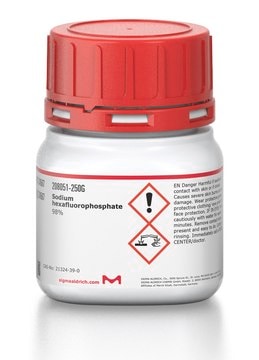450227
Lithium hexafluorophosphate
battery grade, ≥99.99% trace metals basis
Sinônimo(s):
Lithium phosphorus fluoride
About This Item
Produtos recomendados
grau
battery grade
Ensaio
≥99.99% trace metals basis
forma
powder
características do produto alternativo mais ecológico
Design for Energy Efficiency
Learn more about the Principles of Green Chemistry.
sustainability
Greener Alternative Product
Impurezas
≤100.0 ppm Trace Metal Analysis
pf
200 °C (dec.) (lit.)
aplicação(ões)
battery manufacturing
categoria alternativa mais ecológica
cadeia de caracteres SMILES
[Li+].F[P-](F)(F)(F)(F)F
InChI
1S/F6P.Li/c1-7(2,3,4,5)6;/q-1;+1
chave InChI
AXPLOJNSKRXQPA-UHFFFAOYSA-N
Procurando produtos similares? Visita Guia de comparação de produtos
Categorias relacionadas
Descrição geral
Aplicação
Outras notas
Preparation and characterization of lithium hexafluorophosphate for lithium-ion battery electrolyte.
produto relacionado
Palavra indicadora
Danger
Frases de perigo
Declarações de precaução
Classificações de perigo
Acute Tox. 3 Oral - Skin Corr. 1A - STOT RE 1 Inhalation
Órgãos-alvo
Bone,Teeth
Código de classe de armazenamento
6.1B - Non-combustible acute toxic Cat. 1 and 2 / very toxic hazardous materials
Classe de risco de água (WGK)
WGK 2
Ponto de fulgor (°F)
Not applicable
Ponto de fulgor (°C)
Not applicable
Equipamento de proteção individual
Eyeshields, Faceshields, Gloves, type P3 (EN 143) respirator cartridges
Certificados de análise (COA)
Busque Certificados de análise (COA) digitando o Número do Lote do produto. Os números de lote e remessa podem ser encontrados no rótulo de um produto após a palavra “Lot” ou “Batch”.
Já possui este produto?
Encontre a documentação dos produtos que você adquiriu recentemente na biblioteca de documentos.
Os clientes também visualizaram
Artigos
HEVs address rising fuel costs and emissions concerns, utilizing battery packs alongside internal combustion engines for enhanced performance.
Solid-state Li batteries: Review of solid electrolytes, ion conduction, structures, and electrochemical processes.
Solid-state lithium fast-ion conductors are crucial for safer, high-energy-density all-solid-state batteries, addressing conventional battery limitations.
Solid oxide fuel cells and electrolyzers show potential for chemical-to-electrical energy conversion, despite early development stages.
Conteúdo relacionado
Baterias, células de combustível e supercapacitores são dispositivos de conversão e armazenamento de energia baseados na produção de energia eletroquímica na interface eletrodo/eletrólito e na separação do transporte de elétrons/íons.
Batteries, fuel cells, and supercapacitors rely on electrochemical energy production. Understand their operation and electron/ion transport separation.
Nossa equipe de cientistas tem experiência em todas as áreas de pesquisa, incluindo Life Sciences, ciência de materiais, síntese química, cromatografia, química analítica e muitas outras.
Entre em contato com a assistência técnica














